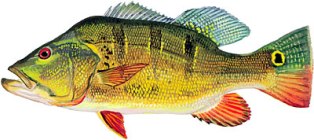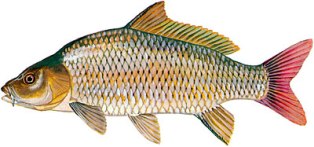Discover Florida Nature
It's time to explore the natural Florida


|
|
|
|
|
 Butterfly
Peacock (Cichla ocellaris) The body shape of the
butterfly peacock is similar to that of a largemouth bass. It's color is
highly variable, but generally golden with three black vertical bars
that tend to fade and are possibly absent in older fish. The butterfly
peacock has a black spot with a yellow-gold halo on it's caudal fin.
Introduced by FWC in large coastal canals of southeast Florida in 1984,
the butterfly peacock has a low tolerance for low water temperatures
below 60oF and of saltwater, preventing this species from
becoming abundant outside of coastal Miami-Dade and Broward counties.
The native range of the butterfly peacock lies within the Amazon River
basin of South America. Successful in warm, slow flowing canals, ponds,
lakes, deep rock pits, and lateral canals, the butterfly peacock is
frequently found in shady areas around bridges, culverts, canal
intersections, bends, dead ends, and near fallen trees. The butterfly
peacock spawns and often feeds in shallow water adjacent shorelines with
overhanging vegetation and feeds almost exclusively on fish. Butterfly
peacock tend to use great speed to capture prey; and typically feeds
only during daylight hours. This fish has helped reduce the number of
undesirable exotic fishes, especially the spotted tilapia. Butterfly
peacock grow rapidly to 12-14 inches during the first 16-18 months,
after which they become much heavier with each inch they add in length.
A 17-inch fish will weigh approximately three pounds while a 19-inch
fish will weigh up to five pounds. Butterfly peacocks are the most
popular sportfish in southeast Florida coastal canals where it generates
millions of hours of fishing pleasure for thousands of anglers who spend
more than $8 million a year to catch them. Butterfly
Peacock (Cichla ocellaris) The body shape of the
butterfly peacock is similar to that of a largemouth bass. It's color is
highly variable, but generally golden with three black vertical bars
that tend to fade and are possibly absent in older fish. The butterfly
peacock has a black spot with a yellow-gold halo on it's caudal fin.
Introduced by FWC in large coastal canals of southeast Florida in 1984,
the butterfly peacock has a low tolerance for low water temperatures
below 60oF and of saltwater, preventing this species from
becoming abundant outside of coastal Miami-Dade and Broward counties.
The native range of the butterfly peacock lies within the Amazon River
basin of South America. Successful in warm, slow flowing canals, ponds,
lakes, deep rock pits, and lateral canals, the butterfly peacock is
frequently found in shady areas around bridges, culverts, canal
intersections, bends, dead ends, and near fallen trees. The butterfly
peacock spawns and often feeds in shallow water adjacent shorelines with
overhanging vegetation and feeds almost exclusively on fish. Butterfly
peacock tend to use great speed to capture prey; and typically feeds
only during daylight hours. This fish has helped reduce the number of
undesirable exotic fishes, especially the spotted tilapia. Butterfly
peacock grow rapidly to 12-14 inches during the first 16-18 months,
after which they become much heavier with each inch they add in length.
A 17-inch fish will weigh approximately three pounds while a 19-inch
fish will weigh up to five pounds. Butterfly peacocks are the most
popular sportfish in southeast Florida coastal canals where it generates
millions of hours of fishing pleasure for thousands of anglers who spend
more than $8 million a year to catch them. Common
Carp (Cyprinus carpio) The common carp is a large,
heavy bodied minnow with an arched back , and a small triangular head
tapering to a blunt snout. This fish has a small, subterminal and
protrusible mouth that contains no teeth, and has two pair of barbels on
the upper jaw. The body color of the common carp is brassy green on top
grading to bronze or gold on sides with yellowish white belly and is
typically covered with large, round scales. The common carp occurs only
in the Apalachicola and Ochlockonee rivers in Florida but is widely
distributed elsewhere in North America in a variety of habitats ranging
from steep natural banks to gentle banks, dike fields, sand disposal
areas, rocky outcrops, and backwater sloughs with or without submergent
vegetation First introduced to the United States in the late 1800's, the
common carp's native range is Europe. Not nearly as abundant in Florida
as most other states, the common carp may not do well with Florida's
short and mild winters. Common carp feed by sucking up bottom silt, and
selectively removing insect larvae, crustaceans, snails, and other small
food items. Adult carp are omnivorous, consuming both plant and animal
foods, and organic debris may also be an important component of the
diet. Few common carp live longer than 12 years in the wild, but in
captivity this fish has lived 47 years. The growth varies considerable
in common carp, but is generally rapid for the first few years, then
slows. They commonly reach more than 10 pounds. Common
Carp (Cyprinus carpio) The common carp is a large,
heavy bodied minnow with an arched back , and a small triangular head
tapering to a blunt snout. This fish has a small, subterminal and
protrusible mouth that contains no teeth, and has two pair of barbels on
the upper jaw. The body color of the common carp is brassy green on top
grading to bronze or gold on sides with yellowish white belly and is
typically covered with large, round scales. The common carp occurs only
in the Apalachicola and Ochlockonee rivers in Florida but is widely
distributed elsewhere in North America in a variety of habitats ranging
from steep natural banks to gentle banks, dike fields, sand disposal
areas, rocky outcrops, and backwater sloughs with or without submergent
vegetation First introduced to the United States in the late 1800's, the
common carp's native range is Europe. Not nearly as abundant in Florida
as most other states, the common carp may not do well with Florida's
short and mild winters. Common carp feed by sucking up bottom silt, and
selectively removing insect larvae, crustaceans, snails, and other small
food items. Adult carp are omnivorous, consuming both plant and animal
foods, and organic debris may also be an important component of the
diet. Few common carp live longer than 12 years in the wild, but in
captivity this fish has lived 47 years. The growth varies considerable
in common carp, but is generally rapid for the first few years, then
slows. They commonly reach more than 10 pounds. Grass
Carp (Ctenopharyngodon idella) The grass carp is
actually one of the largest members of the minnow family. The back of
the grass carp is silvery to dark grey, and the sides of the body are
lighter with a slightly golden sheen. The belly is silvery white. Fins
are generally greenish-grey. The fish has relatively large scales. The
body shape is oblong with a round belly and broad head. Teeth have been
replaced by specialized structures called pharyngeal teeth located in
the back of the throat and are used for tearing and grinding plant
matter. The grass carp is native to large coastal rivers in Siberia
(Amur River) and China that flow into the Pacific Ocean. They are
extensively cultured for food in China, Malaysia, Singapore, Borneo,
Indonesia, Thailand, Taiwan, Hong Kong and the Philippines. The grass
carp only occurs where stocked within Florida. In its native range it
occurs in lakes, ponds, pools and backwaters of large rivers but prefers
large, slow-flowing or standing water bodies with vegetation. As the
name implies grass carp consume higher aquatic plants and submerged
grasses (rooted macrophytes as opposed to algae); they will also eat
detritus, insects and other invertebrates when necessary. Because of
their feeding behavior, they are used in this country under special
restricted circumstances to help manage aquatic plant problems. Many
aquatic plants that pose problems in Florida are exotic and have few
natural insect or disease controls, consequently they frequently create
problems with access, navigation, flood control, irrigation and
aesthetics. The largest triploid grass carp taken in Florida was 15
years old, 56" long and weighed 75 lbs. In China, grass carp are reputed
to live up to 21 years and reach sizes of 5 feet and 100 pounds. Grass
Carp (Ctenopharyngodon idella) The grass carp is
actually one of the largest members of the minnow family. The back of
the grass carp is silvery to dark grey, and the sides of the body are
lighter with a slightly golden sheen. The belly is silvery white. Fins
are generally greenish-grey. The fish has relatively large scales. The
body shape is oblong with a round belly and broad head. Teeth have been
replaced by specialized structures called pharyngeal teeth located in
the back of the throat and are used for tearing and grinding plant
matter. The grass carp is native to large coastal rivers in Siberia
(Amur River) and China that flow into the Pacific Ocean. They are
extensively cultured for food in China, Malaysia, Singapore, Borneo,
Indonesia, Thailand, Taiwan, Hong Kong and the Philippines. The grass
carp only occurs where stocked within Florida. In its native range it
occurs in lakes, ponds, pools and backwaters of large rivers but prefers
large, slow-flowing or standing water bodies with vegetation. As the
name implies grass carp consume higher aquatic plants and submerged
grasses (rooted macrophytes as opposed to algae); they will also eat
detritus, insects and other invertebrates when necessary. Because of
their feeding behavior, they are used in this country under special
restricted circumstances to help manage aquatic plant problems. Many
aquatic plants that pose problems in Florida are exotic and have few
natural insect or disease controls, consequently they frequently create
problems with access, navigation, flood control, irrigation and
aesthetics. The largest triploid grass carp taken in Florida was 15
years old, 56" long and weighed 75 lbs. In China, grass carp are reputed
to live up to 21 years and reach sizes of 5 feet and 100 pounds.
|
|
|
Advertise | Privacy Statement | Dog Encyclopedia | Video |Contact | Alaska Nature |
|